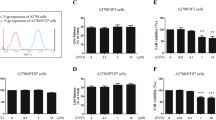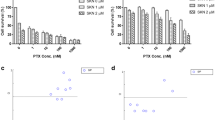Abstract
We previously reported the multidrug resistance-reversing ability of kuguacin J (KJ) in cervical cancer cells via the inhibition of P-glycoprotein (P-gp) function. This study investigated whether KJ could promote cisplatin- and paclitaxel (PTX)-induced cancer cell death in drug-resistance human ovarian cancer cells (SKOV3). Cytotoxicity testing showed that SKOV3 was more resistant to cisplatin and PTX compared to drug-sensitive human ovarian cancer cells (A2780). The cytotoxicity of PTX was significantly increased in SKOV3 cells when co-treated with KJ. We found that enhancement of PTX toxicity in the cells was not related to P-gp inhibition. To elucidate the mechanism by which KJ increases PTX sensitivity, the expression of cell death involving proteins was analyzed by Western blot analysis. The results showed that PTX treatment increased the level of an anti-apoptotic protein, survivin, which may be involved in drug resistance in SKOV3. The co-treatment with PTX and KJ dramatically decreased the level of survivin and markedly induced cleavage of PARP and caspase-3, which are apoptotic-induced molecules. These findings may support the use of KJ as an effective chemosensitizer in combination with conventional chemotherapy to promote PTX sensitization in ovarian cancer patients.





Similar content being viewed by others
References
Dunton CJ (1997) New options for the treatment of advanced ovarian cancer. Semin Oncol 24:S5-2–S5-11
ten Bokkel Huinink W, Gore M, Carmichael J, Gordon A, Malfetano J, Hudson I et al (1997) Topotecan versus paclitaxel for the treatment of recurrent epithelial ovarian cancer. J Clin Oncol 15:2183–2193
Rose PG, Blessing JA, Mayer AR, Homesley HD (1998) Prolonged oral etoposide as second-line therapy for platinum-resistant and platinum-sensitive ovarian carcinoma: a Gynecologic Oncology Group study. J Clin Oncol 16:405–410
Markman M, Blessing JA, Moore D, Ball H, Lentz SS (1998) Altretamine (hexamethylmelamine) in platinum-resistant and platinum-refractory ovarian cancer: a Gynecologic Oncology Group phase II trial. Gynecol Oncol 69:226–229
Shapiro JD, Millward MJ, Rischin D, Michael M, Walcher V, Francis PA et al (1996) Activity of gemcitabine in patients with advanced ovarian cancer: responses seen following platinum and paclitaxel. Gynecol Oncol 63:89–93
Gershenson DM, Burke TW, Morris M, Bast RC, Guaspari A, Hohneker J et al (1998) A phase I study of a daily x3 schedule of intravenous vinorelbine for refractory epithelial ovarian cancer. Gynecol Oncol 70:404–409
Wilson TR, Longley DB, Johnston PG (2006) Chemoresistance in solid tumours. Ann Oncol 17(Suppl 10):x315–324
Kigawa J (2013) New strategy for overcoming resistance to chemotherapy of ovarian cancer. Yonago Acta Medica 56:43–50
Limtrakul P, Khantamat O, Pintha K (2004) Inhibition of P-glycoprotein activity and reversal of cancer multidrug resistance by Momordica charantia extract. Cancer Chemother Pharmacol 54:525–530
Pitchakarn P, Ogawa K, Suzuki S, Takahashi S, Asamoto M, Chewonarin T et al (2010) Momordica charantia leaf extract suppresses rat prostate cancer progression in vitro and in vivo. Cancer Sci 101:2234–2240
Pitchakarn P, Suzuki S, Ogawa K, Pompimon W, Takahashi S, Asamoto M et al (2011) Induction of G1 arrest and apoptosis in androgen-dependent human prostate cancer by Kuguacin J, a triterpenoid from Momordica charantia leaf. Cancer Lett 306:142–150
Pitchakarn P, Ohnuma S, Pintha K, Pompimon W, Ambudkar SV, Limtrakul P (2012) Kuguacin J isolated from Momordica charantia leaves inhibits P-glycoprotein (ABCB1)-mediated multidrug resistance. J Nutr Biochem. 23(1): 76−84
Chen J, Tian R, Qiu M, Lu L, Zheng Y, Zhang Z (2008) Trinorcucurbitane and cucurbitane triterpenoids from the roots of Momordica charantia. Phytochemistry 69:1043–1048
Chen JC, Liu WQ, Lu L, Qiu MH, Zheng YT, Yang LM et al (2009) Kuguacins F-S, cucurbitane triterpenoids from Momordica charantia. Phytochemistry 70:133–140
Mekuria DB, Kashiwagi T, Tebayashi S, Kim CS (2005) Cucurbitane triterpenoid oviposition deterrent from Momordica charantia to the leafminer, Liriomyza trifolii. Biosci Biotechnol Biochem 69:1706–1710
Puspawati N (2008) Isolation and identification momordicin I from leaves extract of Momordica charantia L. Jurnal Kimia 2:53–56
Graf U, van Schaik N (1992) Improved high bioactivation cross for the wing somatic mutation and recombination test in Drosophila melanogaster. Mutat Res 271:59–67
Graf U, Würgler FE, Katz AJ, Frei H, Juon H, Hall CB et al (1984) Somatic mutation and recombination test in Drosophila melanogaster. Environ Mutagen 6:153–188
Würgler FE, Graf U (1985) Mutagenicity testing with Drosophila melanogaster. Basic Life Sci 34:343–372
Salzano G, Navarro G, Trivedi MS, De Rosa G, Torchilin VP (2015) Multifunctional polymeric micelles co-loaded with anti-survivin siRNA and paclitaxel overcome drug resistance in an animal model of ovarian cancer. Mol Cancer Ther 14:1075–1084
Frei H, Würgler FE (1988) Statistical methods to decide whether mutagenicity test data from Drosophila assays indicate a positive, negative, or inconclusive result. Mutat Res 203:297–308
Umsumarng S, Pintha K, Pitchakarn P, Sastraruji K, Sastraruji T, Ung AT et al (2013) Inhibition of P-glycoprotein mediated multidrug resistance by stemofoline derivatives. Chem Pharm Bull 61:399–404
Thomas H, Coley HM (2003) Overcoming multidrug resistance in cancer: an update on the clinical strategy of inhibiting p-glycoprotein. Cancer Control 10:159–165
Ling X, Bernacki RJ, Brattain MG, Li F (2004) Induction of survivin expression by taxol (paclitaxel) is an early event, which is independent of taxol-mediated G2/M arrest. J Biol Chem 279:15196–15203
Laohavechvanich P, Kangsadalampai K, Tirawanchai N, Ketterman AJ (2006) Effect of different Thai traditional processing of various hot chili peppers on urethane-induced somatic mutation and recombination in Drosophila melanogaster: assessment of the role of glutathione transferase activity. Food Chem Toxicol 44:1348–1354
Zimmerli B, Schlatter J (1991) Ethyl carbamate: analytical methodology, occurrence, formation, biological activity and risk assessment. Mutat Res 259:325–350
Davidson B, Trope CG (2014) Ovarian cancer: diagnostic, biological and prognostic aspects. Women’s Health 10:519–533
Gabra H (2014) Introduction to managing patients with recurrent ovarian cancer. EJC Suppl 12:2–6
Khan N, Adhami VM, Mukhtar H (2010) Apoptosis by dietary agents for prevention and treatment of prostate cancer. Endocr Relat Cancer 17:R39–52
Thangapazham RL, Sharma A, Maheshwari RK (2006) Multiple molecular targets in cancer chemoprevention by curcumin. AAPS J 8:E443–449
Zaffaroni N, Pennati M, Colella G, Perego P, Supino R, Gatti L et al (2002) Expression of the anti-apoptotic gene survivin correlates with taxol resistance in human ovarian cancer. Cell Mol Life Sci 59:1406–1412
Kar R, Palanichamy JK, Banerjee A, Chattopadhyay P, Jain SK, Singh N (2015) Survivin siRNA increases sensitivity of primary cultures of ovarian cancer cells to paclitaxel. Clin Transl Oncol 17:737–742
Dong Z, Yang L, Lai D (2013) KLF5 strengthens drug resistance of ovarian cancer stem-like cells by regulating survivin expression. Cell Prolif 46:425–435
Altieri DC (2003) Survivin, versatile modulation of cell division and apoptosis in cancer. Oncogene 22:8581–8589
Yasuda S, Yogosawa S, Izutani Y, Nakamura Y, Watanabe H, Sakai T (2010) Cucurbitacin B induces G2 arrest and apoptosis via a reactive oxygen species-dependent mechanism in human colon adenocarcinoma SW480 cells. Mol Nutr Food Res 54:559–565
Zhang M, Hettiarachchy NS, Horax R, Chen P, Over KF (2009) Effect of maturity stages and drying methods on the retention of selected nutrients and phytochemicals in bitter melon (Momordica charantia) leaf. J Food Sci 74:C441–448
Lin JP, Yang JS, Lu CC, Chiang JH, Wu CL, Lin JJ et al (2009) Rutin inhibits the proliferation of murine leukemia WEHI-3 cells in vivo and promotes immune response in vivo. Leuk Res 33:823–828
Luo H, Jiang BH, King SM, Chen YC (2008) Inhibition of cell growth and VEGF expression in ovarian cancer cells by flavonoids. Nutr Cancer 60:800–809
Martinez Conesa C, Vicente Ortega V, Yanez Gascon MJ, Alcaraz Banos M, Canteras Jordana M, Benavente-Garcia O et al (2005) Treatment of metastatic melanoma B16F10 by the flavonoids tangeretin, rutin, and diosmin. J Agric Food Chem 53:6791–6797
Prakash G, Hosetti BB, Dhananjaya BL (2014) Antimutagenic effect of Dioscorea pentaphylla on genotoxic effect induced by methyl methanesulfonate in the Drosophila wing spot test. Toxicol Int 21:258–263
Guterres ZR, Zanetti TA, Sennes-Lopes TF, da Silva AF (2015) Genotoxic and antigenotoxic potential of Momordica charantia Linn (Cucurbitaceae) in the wing spot test of Drosophila melanogaster. J Med Food 18:1136–1142
Sarikaya R, Erciyas K, Kara MI, Sezer U, Erciyas AF, Ay S (2016) Evaluation of genotoxic and antigenotoxic effects of boron by the somatic mutation and recombination test (SMART) on Drosophila. Drug Chem Toxicol. 4:400−406
Carmona ER, Escobar B, Vales G, Marcos R (2015) Genotoxic testing of titanium dioxide anatase nanoparticles using the wing-spot test and the comet assay in Drosophila. Mutat Res Genet Toxicol Environ Mutagen 778:12–21
Acknowledgements
This work was supported by the Thailand Research Fund (MRG No. 5580128), the Office of the Higher Education Commission, Thailand, the National Research Council of Thailand, the Faculty of Medicine Research Fund, Faculty of Medicine, Center of Excellent in Entomology and Application of Chiang Mai University, Chiang Mai University, and Grants-in-Aid from JSPS Core to-Core Program, B. Asia-Africa Science Platforms. The authors gratefully thank Ms. Crystal A. Young, University of St. Thomas, USA, for proofreading.
Author information
Authors and Affiliations
Corresponding authors
Ethics declarations
Conflict of interest
The authors report no conflict of interest.
Rights and permissions
About this article
Cite this article
Pitchakarn, P., Umsumarng, S., Mapoung, S. et al. Kuguacin J isolated from bitter melon leaves modulates paclitaxel sensitivity in drug-resistant human ovarian cancer cells. J Nat Med 71, 693–702 (2017). https://doi.org/10.1007/s11418-017-1099-0
Received:
Accepted:
Published:
Issue Date:
DOI: https://doi.org/10.1007/s11418-017-1099-0




